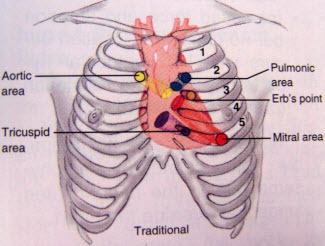Some of the major heart sounds and where to listen for them is something you will need to know for your clinical rotations. This mnemonic can help you remember them easily, and was a great tool for me in nursing school. I hope it helps you too!!
Major heart sounds
Each heart sounds relates to a heart valve, so we will discuss the Aortic, Pulmonic, Erb’s point, Tricuspid, and Mitral valves.

The image above helps you visualize some of these valves that create the major sounds. The mnemonic I learned in school that has stuck with me is the (“APETM”- which I remember as APE To Man)
AORTIC VALVE
The “A” in this mnemonic stands for the “Aortic valve.” You can listen to this at the 2nd intercoastal space on the R side, at the sternal boarder. This signifies the closure of the aortic valve, which occurs when blood leaves the left ventricle and enters the aorta. (Part of the S2 “dub” sound)
PULMONIC VALVE
The “P” in this mnemonic stands for the “Pulmonic valve.” You can listen to this at the 2nd intercoastal space on the L side, at the sternal boarder. This signifies the closure of the pulmonic valve, which occurs when blood from the R ventricle flows into the lungs. (Part of the S2 “dub” sound)
ERB’S POINT
The “E” in the pneumonic stands for the “Erb’s point.” You can listen to this at the 3rd intercoastal space on the L side, at the sternal boarder. This signifies the center area where the heart sits.

TRICUSPID VALVE
The “T” in the mnemonic stands for the “Tricuspid valve.” You can listen to this at the 4th intercoastal space on the L side, at the the sternal boarder. This signifies the closure of the valve between the R atrium and R ventricle, which occurs after blood moves from the R atrium to the ventricle. (Part of the S1 “lub” sound)
MITRAL VALVE
The “M” in the mnemonic stands for the “Mitral valve.” You can listen to this at the 5th inter-coastal space on the L side, at the mid-clavicular line. This signifies the closure of the valve between the L atrium and L ventricle, after blood leaves the L atrium and moves to the ventricle. (Part of the S1 “lub” sound)
KEY POINTS
- Mnemonic is “APETM”, which you can remember as APE To Man.
- Using this mnemonic, only the Aortic valve is listened to on the R side, the rest are heard on the L side.
- Only the Mitral valve is located at the mid- clavicular line, while the rest are at the sternal boarder.
I hope you find this helpful when you begin listening to heart sounds. Please visit here for a more in-depth coverage and more visual explanation on this topic. Remember, listening to heart sounds takes practice, so don’t forget to give yourself time to acquire this skill.
Visit my other posts on IV fluids made easy and inspirational quotes for nursing students. Feel free to email me with any questions or comments that you may have.






This post has 9 comments
Abdurrahman
28 Jun 2020Good article
Ike
28 Jun 2020Wow…this is an awesome way to remember the heart sounds!! Definitely easier to remember now. Thank you!
ursulatries
28 Jun 2020Thank you very much. I’m glad it will be useful to you!!
Nma
28 Jun 2020You are gracious to have chosen an Article that relates to the Heart. The heart is the key to life. Well done
EMMANUEL
28 Jun 2020Gained a lot reading this
Swapnil musale
28 Jun 2020It’s nice
Oge
28 Jun 2020Lovely Read broken down really well.!!!!!
Osinachi
29 Jun 2020A short but very insightful summary of the heart sounds. I hope there will be subsequent articles about the heart soon.
Ben
7 Jul 2020Nice one
Comments are closed.